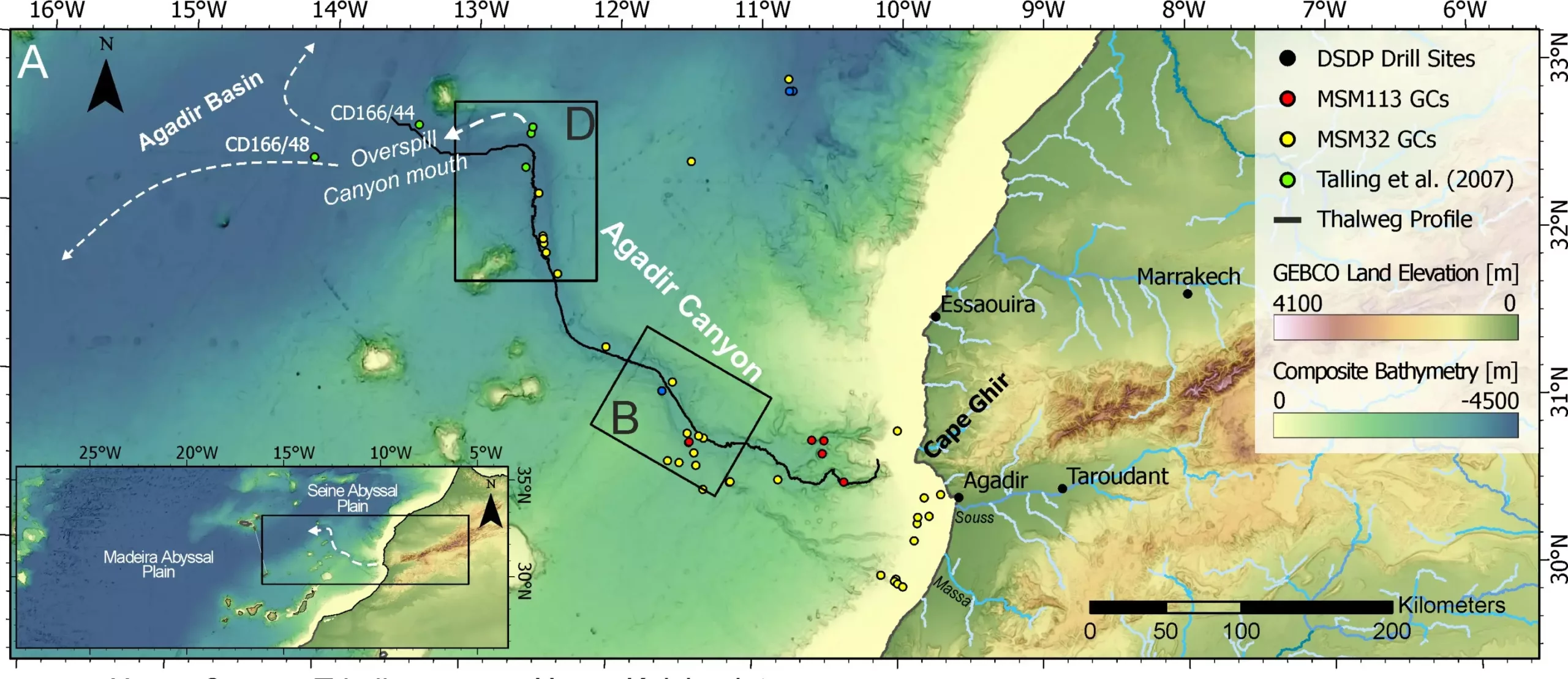Recent studies conducted by the University of Liverpool have brought to light the staggering capabilities of underwater avalanches, an often-overlooked geological process that can unleash tremendous destructive power beneath the ocean’s surface. These underwater phenomena, which remain elusive and difficult to observe directly, play a critical role in sediment transport, affecting everything from ocean floor structure to global internet infrastructure. One particular avalanche, originating in the Agadir Canyon, presents a striking case study, having expanded over 100 times in volume to devastate a vast stretch of the Atlantic Ocean seafloor.
In the study titled “Extreme erosion and bulking in a giant submarine gravity low,” published in Science Advances, researchers utilized extensive data collection—analyzing over 300 core samples gathered from regional research cruises over the past four decades. What sets this research apart is the comprehensive mapping of an underwater avalanche that occurred roughly 60,000 years ago, marking a significant advancement in our understanding of these geological events. Led by Dr. Chris Stevenson, the research team meticulously detailed the avalanche’s trajectory, starting from a seemingly innocuous 1.5 km volume seafloor landslide to a monumental force that carved away at the canyon walls and transported watchful sediments across 2,000 km of the ocean floor.
To conceptualize the sheer force of this underwater avalanche is to envision a calamity on a truly colossal scale. As the avalanche surged, it generated a trench 30 meters deep and 15 kilometers wide, uprooting and displacing boulders and sediment alike. Estimations place its maximum height at a staggering 200 meters, translating into a natural disaster not unlike a faltering skyscraper, roaring through the ocean at a speed of 15 meters per second—equivalent to about 40 miles per hour.
Dr. Stevenson emphasizes the abrupt transformation from a small slip to a cataclysmic event, stating that this unusual growth factor, exceeding 100 times the original volume, is unparalleled when compared to conventional landslides or debris flows in terrestrial environments, which typically compact to a mere four to eight times their original size. This drastic alteration highlights a potential behavior pattern unique to underwater avalanches, meriting further exploration for the sake of both scientific inquiry and practical impact.
The ramifications of such colossal underwater avalanches extend beyond the turbulence of ocean currents. As noted by the research team, the fundamental nature of these events suggests a pressing geohazard risk to critical seafloor infrastructures—particularly internet cables that weave along the ocean floor, facilitating global communication and commerce. The findings compel us to re-evaluate our perceptions regarding underwater geological instability and adapt our risk assessment frameworks accordingly.
Professor Sebastian Krastel, head of Marine Geophysics at Kiel University, articulates this sentiment by stating that previously held theories have been significantly challenged. Prior to this research, the consensus projected that significant avalanches could only result from substantial slope failures. Emerging evidence indicates that a small disturbance can foment into a vast and destructive geological force.
Given the staggering implications of this research, it becomes essential that we integrate such knowledge into our policies and practices surrounding oceanic infrastructure. As our reliance on the internet escalates—a demand accentuated by recent global trends such as remote work and digital communication—understanding the risks posed by geological events beneath the ocean’s surface becomes increasingly urgent.
In this regard, the collaboration of leading institutions, including the Institute of Geosciences at Kiel University and GEOMAR Helmholtz Centre for Ocean Research, highlights the interdisciplinary effort aimed at decoding mysteries long hidden beneath the waves. Future research endeavors ought to focus on not just understanding the dynamics of underwater avalanches but also developing predictive models enabling better preparedness for potential hazards they pose.
The findings from the University of Liverpool illuminate a previously unexplored aspect of geophysical processes, encouraging a deeper dialogue around the intersection of natural occurrences and human infrastructure. As we advance our technological capabilities, the responsibility collectively lies upon us to ensure that we understand and mitigate the risks associated with this geological dynamism. Only then can we adequately protect our expanding global community from the unpredictable nature of underwater avalanches and promote a more resilient interplay between our world and the turbulent oceans that surround us.

